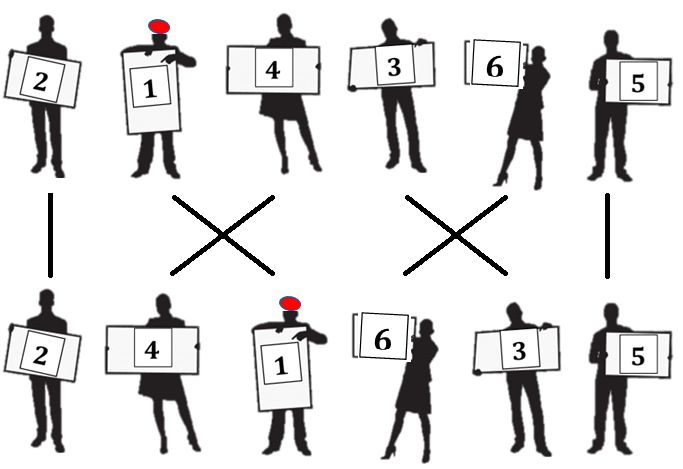Handbell Toolbox
2. Strong foundation skills
2.3. What is Plain Hunt
This page is aimed mainly at those who have not rung tower bells. If you are a confident tower bell ringer you may wish to jump to the next page of this book.
What is Plain Hunt?
You have already rung rounds and exercises in which you move your bells within the row with someone calling when the changes are made. Plain Hunt is the first time that you will change the position of your bells at every row, using a set of rules to determine the change that is made, rather than being told by the conductor. Let's look at how Plain Hunt works, sometimes known as its structure or place notation.
Starting from rounds, pairs of bells (1-2, 3-4 and 5-6) cross:

If all the bells crossed again they would arrive back where they started, at rounds. Instead, in Plain Hunt the new bells in first and last position (the 2 and 5) stay where they are and the two inside pairs of bells cross with their new partners:

Plain Hunt consists of repeats of these two changes. This is known as a (x16) block, but don't worry too much about that at the moment. Let's look what happens when the three pairs of bells cross again:

If you look at the place that the treble (1) bell (with the red hat) rings in each row, you'll start to see a pattern, this is the plain hunt pattern. All the bells ring this pattern starting at a different place in rounds at the beginning.
Repeating the operation of alternating all three pairs crossing and then only the two internal pairs crossing will eventually generate rounds again and what ringers call a course of Plain Hunt will have been rung.
Looking not at the people/bells in the above images but the crossing patterns inbetween the rows, the above changes could be written as:
X X X
I X X I
X X X
I X X I etc...
Write out Plain Hunt
Write out Plain Hunt for yourself now with all the bell numbers written in. Alternate between all the bells crossing (bells in positions 1-2, 3-4 and 5-6) then the middle bells crossing (bells in positions 2-3 and 4-5). Here's the start:
1 2 3 4 5 6
2 1 4 3 6 5
2 4 1 6 3 5
4 2 6 1 5 3
4 6 2 5 1 3 etc...
Keep going till you are back at rounds.
Plain Hunt explained
Have a look at the Plain Hunt chapter of the method toolboxes to find out more.
